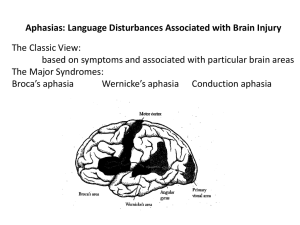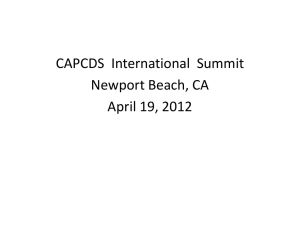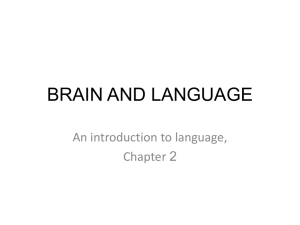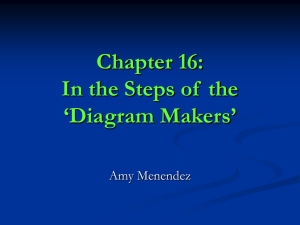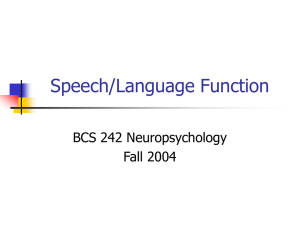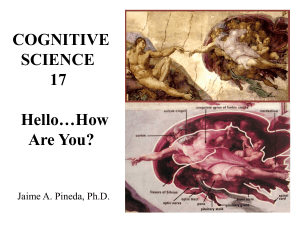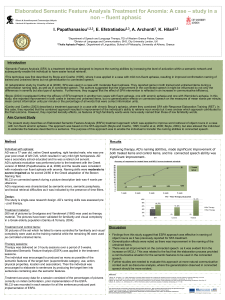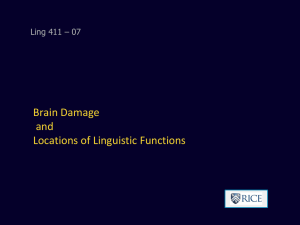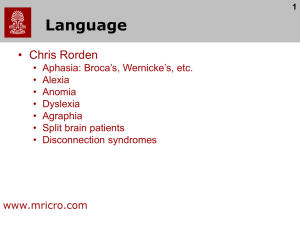File - Erkan Karabacak
advertisement
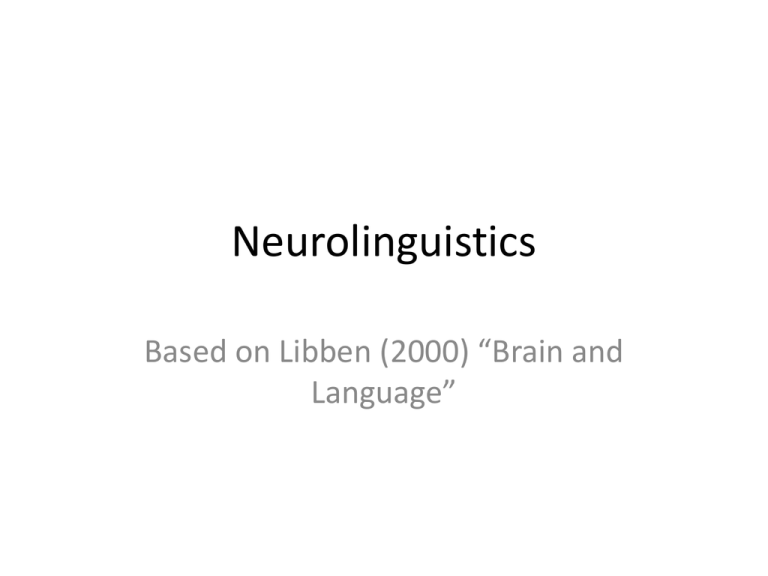
Neurolinguistics Based on Libben (2000) “Brain and Language” Brain and Language 1.The human brain 1.1.The cerebral cortex 1.2.The cerebral hemispheres 1.3.The lobes of the cortex 2.Investigating the brain 2.1.Autopsy studies 2.2.Images of the living brain 2.3.Learning from hemispheric connections and disconnections •Dichotic listening studies •Split brain studies 3. Aphasia 3.1. Non-fluent aphasia •Broca’s aphasia as a syntactic disorder 3.2.Fluent aphasia (sensory aphasia) -Wernicke’s aphasia -Jargonaphasia 4.Acquired dyslexia and dysgraphia 4.1.Reading and writing disturbances in aphasia -paragraphia 4.2.Acquired dyslexia as the dominant language deficit -phonological dyslexia -surface dyslexia 5.Linguistic theory and aphasia 5.1.Features, rules, and underlying forms 5.2.Agrammatism 5.3.Function words 5.4.Loss of syntactic confidence 5.5.Agrammatism in other languages 6.Where is language? Introduction Neurolinguistics: How language is represented and processed in the brain. -survey of brain structure -methods to study the brain -language disturbances that result from brain damage -how phonology, morphology, syntax, and semantics may be represented in the brain -Where is language? 1.The human brain 1400 grs of pinkish-white matter Neuroscience: how the breadth and depth of human experience is coded in the brain matter. Neurons: basic information-processing units of the nervous system 10 Billion neurons Each neuron can link with 10 thousand others 1.1.The cerebral cortex Spinal cord VS Brain VS cerebral cortex Human VS animals Folded 1.The human brain (Continued) 1.2.The cerebral hemispheres Sulci (fissure) Gyri Longitudinal fissure, cerebral hemispheres, corpus callasum Contralateral responsibilities, Left hemisphere controls the right side and vice versa Left-hemisphere: analytical tasks, such as arithmetics Right-hemisphere: overall appreciation of complex patterns, such as face recognition, melodies But, complex mental activities involve the coordinated functioning of both hemispheres Right-handed and left lateralized for language Left-hemisphere is removed but still comprehends some language Right-hemisphere damaged, difficulty in understanding jokes and metaphors Left-handers are less lateralized for language 1.3.The lobes of the cortex Lobe: substructures of the cortex Occipital lobe, plays an important role in reading 2.Investigating the brain Techniques to investigate what is going on in the brain when people are engaged in language behavior. 2.1.Autopsy studies Observe patient’s behavior and, once dead, examine his brain. Broca’s research, Broca’s area, Broca’s aphasia 2.2.Images of the living brain Computerized Axial Tomography (CT scanning) Positron Emission Tomography (PET), glucose + isotopes Functional Magnetic Resonance Imaging (fMRI) It was found that when people -speak, blood flows to left hemisphere and Broca’s area -read, occipital lobe, angular gyrus, other areas of the left hemisphere -SL processing involves a wider variety of cortical sites, less automatic nature of language requires additional diverse mental processes 2.Investigating the brain (continued) 2.3.Learning from hemispheric connections and disconnections Examining behavior that can be associated with a particular brain hemisphere •Dichotic listening studies -language is processed better through right ear (Right Ear Advantage, REA) •Split brain studies -Studying effects of the removal of corpus callosum on cognition -blindfolded patients holding a key in left hand cannot name it 3. Aphasia -stroke (a cerebrovascular accident) -aphasia (language deficit caused by a damage to the brain) -Moss’s experience 3.1. Non-fluent aphasia (motor aphasia) -damage to the front central sulcus -effortful speech production -global aphasia, completely mute -Broca’s aphasia, some phonemes miss, dysprosody, phonemic paraphasias -Broca’s area has a language specific responsibility •Broca’s aphasia as a syntactic disorder -function words are omitted: telegraphic speech -disturbance of syntactic competence -omit inflectional suffixes -grammaticality judgment is difficult, *“The boy ate up it.” -cannot interpret based on the syntax of the sentence, “The cat chased by the mouse.” -Broca’s aphasia is not simply a production deficit -Broca’s aphasics are acutely aware of their language deficit -Broca’s area of frontal lobe does not seem to be involved in the semantic relationships between words -and the relationship between units of language and units of thought. 3. Aphasia (continued) 3.2.Fluent aphasia (sensory aphasia) -damage to the left cortex behind the central sulcus -language production is OK but difficulty in selecting, organizing, and monitoring the production -Wernicke’s aphasia -generally unaware of their deficit -everything seems normal except rarely make sense -comprehension deficit -no coherent trains of thought -Jargonaphasia, Severe case of Wernicke’s aphasia, intonational charecteristics of the language is OK, but very few actual sentences 4.Acquired dyslexia and dysgraphia Dyslexia: impairment of reading ability Dysgraphia: impairment of writing ability Acquired VS developmental dyslexia dysgraphia 4.1.Reading and writing disturbances in aphasia -whatever impairment the patient has in listening and speaking will be matched in reading and writing. -most Broca’s aphasics show writing disturbances that are comparable to their speaking deficits -the resulting error is paragraphia -production deficit at a very deep level of language planning -Wernicke’s aphasia, like Broca’s aphasia involves a central disturbance of language competence 4.Acquired dyslexia and dysgraphia (continued) 4.2.Acquired dyslexia as the dominant language deficit -damage in and around the angular gyrus of the parietal lobe -theory: readers maintain a set of spelling-to-sound rules that enables them to read new words aloud. -phonological dyslexia: loosing spelling-to-sound rules; not able to read unknown words -surface dyslexia: the opposite, processing words only spelling-to-sound rules, regularly spelled words are OK, but irregularly spelled words are poblematic: “worm” is perceived as opposite of “cold”. 5.Linguistic theory and aphasia For aphasia researchers: -Not simply what the patients can or cannot do -but the deficit in terms of the loss of semantic features, phonological features, phonological rules, and syntactic tree structures For Theoretical linguists: -distinctions between derivational and inflectional suffixes 5.1.Features, rules, and underlying forms -phonological features and rules may be good tools to characterize how language is represented and produced (with vs /wit/) -morphology: inflectional is dropped, derivational is retained -illegal inlegal -semantics: deep dyslexia: father mother. -abstract words are more difficult to produce than concrete ones -concrete words are more difficult than abstract words; selective inability: inability to produce names for fruits and vegetables 5.Linguistic theory and aphasia (continued) 5.2.Agrammatism -agrammatism: telegraphic speech, grammar is lost, omission of function words and inflectional affixes -comprehension deficit where correct interpretation solely depends on syntax -characteristics of the syndrome and characteristics of particular languages 5.3.Function words -prepositions: are they function words or lexical words? 5.4.Loss of syntactic confidence -is hierarchical representation lost? Assigning meaning to first noun rather than the NP 5.5.Agrammatism in other languages -true nature of agrammatism is not dropping function words and inflectional affixes. -Hebrew: kotev (writes) VS katev (wrote) -so, it is not simply an economy effort, misselection of linguistic forms 6.Where is language? Broca’s area: -articulation of speech -create syntactic representation Wernicke’s area: -language comprehension Right above Wernicke’s area, angular gyrus: reading Normal language use involves the integrated functioning of the entire cortex. Storage and retrieval of word forms may be diffusely represented in the brain. What is language is a more important question. Summing up • Left-hemisphere of the brain carries most of the responsibility for language processing. • Most of our knowledge about language representation comes from the study of aphasia—language disturbance resulting from damage to the brain. Questions 1.What distinguishes the human brain from a non-human brain? 2.In what ways can the cerebral hemispheres be considered to be two separate brains? […]
